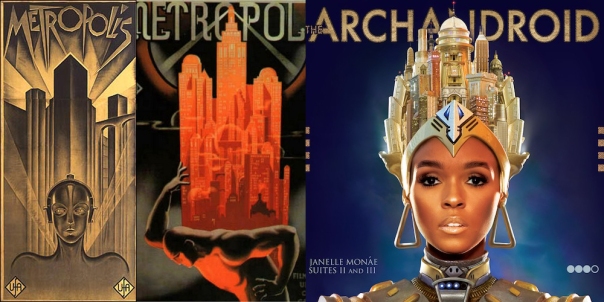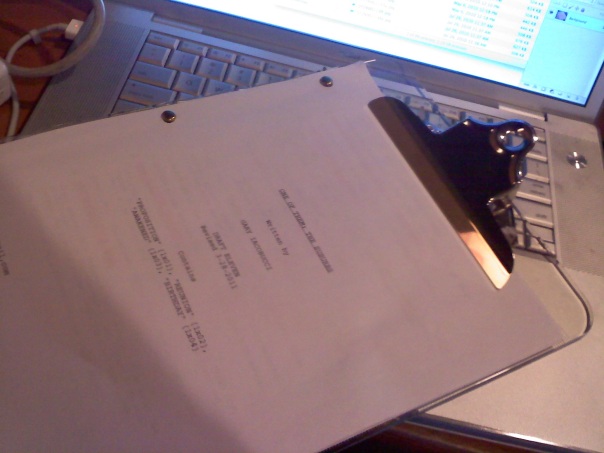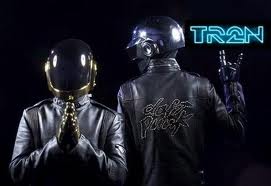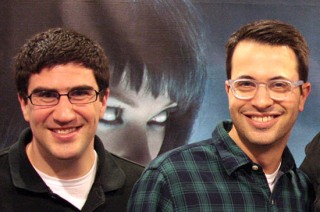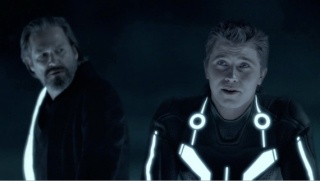Preview the New (Self-Hosted) ModMyth Site
CLICK HERE TO PREVIEW THE NEW SITE
This blog, hosted at WordPress.com, will soon be replaced with a self-hosted official Modern Mythos Media website, which will finally integrate and unify the “personal blog” feel of this site with the services offered information of the (now defunct) Modern Mythos Media website.
Feel free to navigate the site, temporarily hosted at garyiacobucci.dreamhosters.com (although by the time you read this, www.modmythmedia.com should be redirecting there.) However, understand that a “Pardon our dust” disclaimer is in effect. It’s not officially open for business yet.
Janelle Monáe cites her inspiration
Not only is her music extremely listenable, and her style refreshingly business, but her influences are fantastic:
In a November 2009 interview, Monáe revealed the title and concept behind her album, The ArchAndroid. The album was released on 18 May 2010. The second and third suites of Metropolis are combined into this full-length release, in which Monáe’s alter-ego, Cindi Mayweather—also the protagonist of Metropolis: The Chase Suite— becomes a messianic figure to the android community of Metropolis.[10] Monáe noted that she plans to shoot a video for each song on The ArchAndroid and create both a movie and graphic novel based on the album.[11] The Metropolis concept series draws inspiration from a wide range of musical, cinematic and other sources, ranging from Alfred Hitchcock to Debussy to Philip K. Dick. However, the series puts Fritz Lang’s 1927 silent film Metropolis, which Monáe referred to as “the godfather of science-fiction movies,” in special regard.[12][13] Aside from sharing a name, they also share visual styles (the cover for The ArchAndroid is inspired by the iconic poster for Metropolis), conceptual themes and political goals, using expressionistic future scenarios to examine and explode contemporary ideas of prejudice and class. Both also include a performing female android, though to very different effect. Where Metropolis android Maria is the evil, havoc-sowing double of the messianic figure to the city’s strictly segregated working class, Monáe’s messianic android muse Cindi Mayweather represents an interpretation of androids as that segregated minority, which Monáe describes as “… the Other. And I feel like all of us, whether in the majority or the minority, felt like the Other at some point.”
(from Wikipedia)
“Shelved: The Rise and Fall of 11:11” arriving in November
(Cross-posted at LArevivalist)

ModMyth Media is all about the new cinema of grassroots, online-distributed filmmaking. Orange County is just far enough outside the hills of Hollywood that there is a definite alternative feel to the operations of filmmaking outlets here. Huntington Beach-based Hourglass Pictures, headed by Rocky Costanzo, is a virtual poster child for this kind of DIY ethos in 21st century vid-cinema.
I had the pleasure, in 2009, of documenting the making-of process for a long-gestating Costanzo project, 11:11. The film was suddenly undone, at the 11th hour (pardon the pun) by the kind of production problems that reveal just how temperamental and frail the filmmaking process can be outside the protective barrier of the big tentpole operations.
But the footage I shot throughout the process is getting to see the light of day with a new doc, Shelved: The Rise and Fall of 11:11. Here’s the full press release:
Huntington Beach, CA (PRWEB) July 22, 2011
The new Independent Film Production/Distribution Company of filmmaker, Rocky Costanzo, is proud to announce that they will be making a feature-length documentary on Costanzo’s seven year-long film project, “11:11.” The highly-anticipated film, which began production back in 2004 and has still not been released. Although the title for this documentary; “Shelved: The Rise and Fall of 11:11” is tongue-in-cheek, it is also quite symbolic, as the mentioned film, “11:11,” found itself near the top of popularity charts of film industry sites, such as the Internet Movie Database. The online promotional trailers for the film have been viewed by the tens of thousands, and several festivals around the world have invited the film to premiere. Yet, the film remains on the shelf collecting dust. So what is the deal? The answers will come out in this documentary with the untold story.
When developing 11:11, Costanzo brought in an aspiring filmmaker, Gary Iacobucci to shoot an extensive “making-of” documentary to be used as a special feature on the film’s Blu-ray/DVD. What he captured instead, was the rise and fall of his film. Costanzo said, “Gary’s camera was with us every step of the way, including the development meetings, auditions, location scouts, the table read, and of course every day on the set. He had hours and hours of footage.” This footage will appear in the documentary, along with current interviews with every major onscreen and behind-the-scenes player and visual anecdotes sprinkled throughout. The production team is working around the clock with plans for release this November …the year of 11/11/11.
Costanzo, who is expected to oversee the project (though gives the “Director” credit to Gary) will sit in on the editing process. “The support for this film has been so incredibly overwhelming.” says Costanzo. “It’s very important to me that, since we are not sure what the future holds for “11:11,” this documentary will at least give the audience something in return for their patience of waiting so long. In other words, if we can’t give them 11:11, we need to give them the next best thing.
‘Shelved’ is expected to be included in a four-picture distribution deal through Hourglass Pictures and will be exclusive to the digital distribution market, including iTunes, Netflix, Amazon and VOD. Costanzo’s past films, “Hallowed,” “Amhurst,” and “Return to Innocence” will round out the other three.
About Hourglass Pictures:
After dissolving the independent production group, LifeLine Entertainment, Inc. after a ten-year run, filmmaker, Rocky Costanzo launched his privately-owned production company in 2010 with the mission of creating and developing cutting edge films and presenting them in true independent style. Titles, which target niche audiences who appreciate the smaller-budget art house films. New projects are already in the works.
I’ll post more as info becomes available.
The Future of LArevivalist and ModMyth Media Online
Cross-posted from LArevivalist:
I have not updated LArevivalist in quite some time. But I want to make clear that I have not forgotten or abandoned it.
On the contrary, it became clear to me that the site’s potential usefulness and popularity has outgrown my ability to adequately maintain it as a “side project” along my other ventures, chiefly the production of One of Them: The Suburbs, premiering online in October.
I can’t say for sure when LArevivalist will come back, but I hope that it will be soon. What I can say is that my plan is to hand the day-to-day updating operations over to a staff of fellow SoCal cinephiles, and stay on board as Editor-in-Chief. When it returns, it will likely do so in a modified form–some combination of the original, single-film posts, and the longer-form “LArev 2.0” articles.
In the meanwhile, I welcome everyone reading this to follow me on Twitter @garyiacobucci, where I will be sure to update on the progress of ModMyth Media’s projects. The (admittedly underdeveloped) ModMythMedia.com blog remains active, and I will try to post on that with greater regularity as One of Them moves into post-production. This blog will soon be revamped and expanded with an all-new, original design that will better unify the various online tendrils of Modern Mythos Media and LArevivalist.
Lastly, look for the first arc of One of Them in October! It heralds the beginning of a new era for myself and my company. I am excited to be a part of a new generation of digital storytellers who are embracing the future of cinema.
See you back here sometime soon,
Gary Iacobucci
Owner, Modern Mythos Media
www.garyiacobucci.com
GaryIacobucci.com!

Right now, you can enter “www.garyiacobucci.com” in your address bar and be taken to my launch page, where the various tendrils of my online presence meet.
It’s courtesy of flavors.me, a web service that’s part of a new wave of such sites, designed to act as a kind of fast-acting adhesive for the digital soul’s growing collection of blogs, microblogs, web sites, online portfolios, and social networking profiles.
I can’t recommend this service enough if you’re looking for a quick, no-pain way to fix your web presence. First, you will you get a nice simple address (flavors.me/yourusername, unless you forward your own domain like I did) that you can give people and clients.
But more invaluable than that, your SEO will go up like that. Before I created my launch page, Googling “gary iacobucci” resulted in a few scattered posts to my dad’s O.C. band (the Gasoline Addicts) and some robo-copied YouTube clickspam pages of the “Laser Mission” music video I made, like, four years ago.
But now? The first thing that shows up is my LinkedIn profile, and right behind that is GaryIacobucci.com! (Of course, starting out with a name like “Gary Iacobucci” helps. For all the “John Williams” of the world…well, good luck.)
New Home!
The M3 blog, formerly housed at modmythmedia.blogspot.com, is joining its sister site LArevivalist here at WordPress!
All ModMyth news, as well as my personal blog posts and movie reviews, will now be found at:
www.modmythmedia.wordpress.com. (That’s where you are now.)
>"Tron Legacy" (2010)
>Tron Legacy has opened to a fair degree of criticism. Nobody disputes the high caliber of design, and praise has similarly been directed towards the Hans-Zimmer-meets-dance-club score by robotwin duo Daft Punk, a natural fit for the neon-ensconced universe of Tron if ever there was one.
But the biggest thing holding this movie back from being more than a guilty pleasure is the script, penned by Eddie Kitsis and Adam Horowitz. That fact is a bit of a letdown for me as a LOST aficionado, as their names will be familiar to fans of the show–the writing partners had their names on no less than twenty episodes of the series, in addition to serving as executive producers for much of its run. Where LOST had hugely imaginative big-picture stories to tell and had fun filling in the details, with Tron, it’s quite clear the creative forces behind the project spent a lot of energy creating a world like you’ve never seen before, and relied on a very bare bones, How-to-Write-a-Screenplay story arc for the narrative.
Such an imbalance of immense production resource and impotent writing is nothing new in Hollywood. In fact, it’s endemic. Transformers, and in fact Michael Bay’s entire oeuvre, is my go-to example of this imbalance.
I have never been a believer of the “it’s just a popcorn movie” defense. I hold up Raiders of the Lost Ark and RoboCop as examples of “popcorn” movies that can be so much more than anything Bay has managed to conjure — Raiders, for its bar-setting craftsmanship, and RoboCop, for its pitch-perfect blending of 80s genre convention and subversive social commentary. It’s borderline offensive, frankly, that a studio will spend a half-billion dollars on a movie like Avatar. For all that film’s technical showmanship, it featured a script that seemed like a second draft–its characters so archetypical, its political commentary so ham-fisted it made this dyed-in-the-wool liberal want to drive a Humvee through a tolerance rally on his way to the shooting range.
So why, then, did I not feel I had been patronized by the formulaic storytelling of Tron: Legacy? Why did I, in fact, really enjoy it?
Frankly, I was “bought out” by the allure of its images, its sounds, and its movement. But let us not forget that cinema is an art form that first and foremost is about the arousal of the senses. Unlike Avatar‘s techno-organic world, which echoed everything in the last decade already seen in the Star Wars prequels and Lord of the Rings, or the brutishly ugly, overripe world of Transformers, the screen has never seen anything that looks like Tron:
The movie’s other saving graces come from the moments of lightheartedness that alleviate the grim mood practically mandated in genre pictures these days. Brides’ Flynn has sort of morphed into Lebowski’s ‘The Dude’ since we last saw him–it’s been several years since I watched the original Tron, but I don’t recall Flynn possessing the same kind of “New Mexico zen” vibe that Bridges gives off here, as he calls people “Man” and waxes philosophic on the “biodigital jazz” of his electronic world.
It’s a good choice, though–Bridges’ persona has become almost intertwined with that career-defining character, and it gives him a chance to stand apart from the techno-bobbleheads that populate Flynn’s creation.
Olivia Wilde makes Quorra an alluring, tomboyish pixie of a sidekick, and for whatever faults the script posesses, the authors wisely never let her and protagonist Sam achieve the perfunctory late-second-act romance. Sam, for his part, is a stony-faced and rather forgettable character–the same kind of devil-may-care-rich-kid-who-learns-to-make-a-difference (spoiler alert) that is everywhere in these movies these days. No joke, before Tron started rolling, the trailers for The Green Lantern and The Green Hornet demonstrated virtually identical protagonists. (Some have pointed out the shot-for-shot similarities between how Lantern’s backstory and Iron Man‘s backstory are established in their respective trailers.)
If it does come to pass that this most improbable of films–a mega-budget sequel to a once-forgotten children’s movie from a quarter-century ago–garners a threequel, it will have to do better. The permissiveness granted by sheer novelty will have worn off. But for now, it’s nice to go back to the Grid.
P.S.: So, this is a movie called “Tron,” right? And the titular character is only in it as a second-string supporting character until he makes a crucial, if unexplained, decision late in the third act? And we never get a good look at his face? Umm, okay. Someone probably should have made a “note” to the writers on that one.
>"Chinatown" (1974)
>
One of the most emotionally-engaging and structurally proficient scripts I’ve ever seen. The finest balance of Hollywood classicism and European art cinema any director has ever conjured. A story rooted in the geographical psychology–and the pulse–of Los Angeles, something far too rare in the pictures considering the industry’s location.



